Today we have Intel Xeon D-1587 benchmarks. Our most popular topic in 2015 was Intel Xeon D and in November 2015 we heard about the Intel Xeon D wave 2 launch. Continuing the tradition of having the first benchmarks of the Xeon D-1540 and Xeon D-1520 with the initial wave of Xeons. We also have the first Xeon D-1518 benchmarks, Xeon D-1528 benchmarks, and Xeon D-1541 benchmarks. The Intel Xeon D-1587 is a 16 core 32 thread processor with 24MB L3 cache. Base frequencies are ~1.7GHz which are a big reason for the 65w TDP part. What you are about to see is nothing short of a complete low-end SoC revolution.
Test Configuration
Our test platform is the Supermicro X10SDV-7TP8F. We will have a review of the motherboard shortly, complete with power and thermal imaging as we normally do.
- CPU: Intel Xeon D-1587 (embedded)
- Motherboard: Supermicro X10SDV-7TP8F
- Memory: 64GB – 4x Samsung 16GB DDR4 2133MHz ECC RDIMM
s
- SSD: 1x Intel DC S3700 400GB
- Operating System: Ubuntu 14.04.3 LTS, OpenSUSE 13.2
As another note, we tried picking some interesting comparisons out of our dataset. We added an AWS EC2 c4.4xlarge instance and a dual Intel Xeon E5-2620 V3 server as comparison points. We are also going to have a full review of an example system that can fit within 1A at 120V using this platform.
Intel Xeon D-1587 Benchmarks
For our testing we are using Linux-Bench scripts which help us see cross platform “least common denominator” results. We are using gcc due to its ubiquity as a default compiler. One can see details of each benchmark here. We are likely going to update the Linux-Bench in the near future with a few new tests as well as an even simpler to use/ faster revision, but for now, we are using our old Ubuntu 14.04.3 version that can be found by running:
sudo bash (curl -sk http://linux-bench.com/lb-test.sh)
You can use that command from a Ubuntu 14.04 LTS system with curl installed to compare your system to our results.
c-ray 1.1 Performance
We have been using c-ray for our performance testing for years now. It is a ray tracing benchmark that is extremely popular to show differences in processors under multi-threaded workloads.
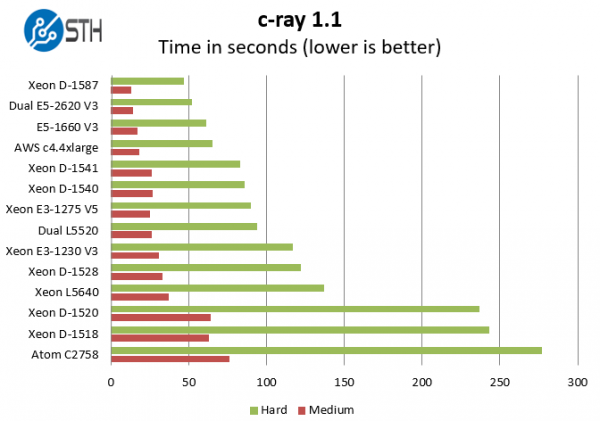
As one can see, on c-ray, a heavily threaded benchmark, the Intel Xeon D-1587 is extremely competitive with a low end, hyper-threading enabled Intel Xeon E5-2620 V3 system. The reason we picked that particular configuration for comparison is that those are extremely popular chips.
7-zip Performance
7-zip is a widely used compression/ decompression program that works cross platform. We started using the program during our early days with Windows testing. It is now part of Linux-Bench.
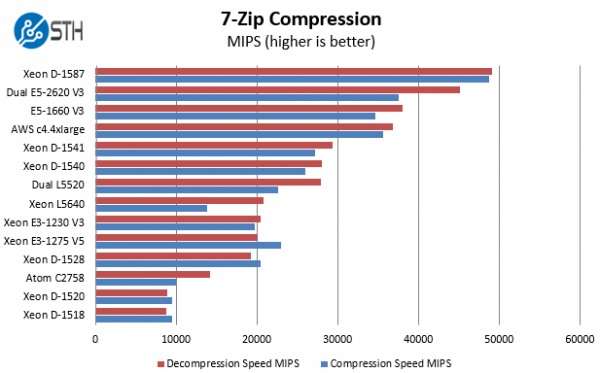
Compression is a major operation we see in today’s workloads and is also highly threaded. We can see that when the chip can take advantage of its cores, it is highly competitive with 12 core / 24 thread Xeon E5 V3 configurations.
NAMD Performance
NAMD is a molecular modeling benchmark developed by the Theoretical and Computational Biophysics Group in the Beckman Institute for Advanced Science and Technology at the University of Illinois at Urbana-Champaign. More information on the benchmark can be found here.
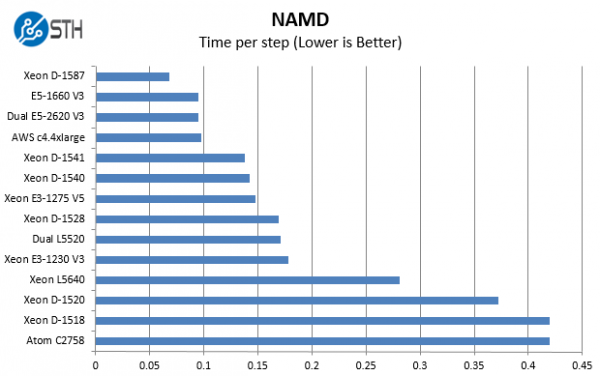
This is certainly a solid showing by the Intel Xeon D-1587 chip due to multi-threaded capabilities.
Sysbench CPU test
Sysbench is another one of those widely used Linux benchmarks. We specifically are using the CPU test, not the OLTP test that we use for some storage testing.
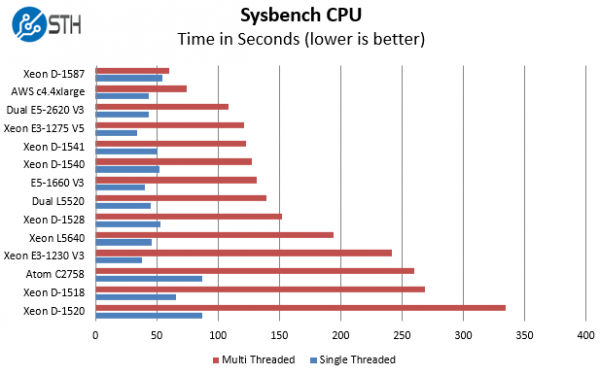
We sorted this chart on the multi-threaded results. Practically that means that the blue bars representing single threaded performance would change the ranking. For example, the Intel Xeon E3-1275 V3, the Intel Xeon E5-2620 V3 and the AWS EC2 c4.4xlarge all have strong single threaded showings compared to the Xeon D-1587. Once the cores are able to be utilized, the Xeon D-1587 does show some impressive performance.
OpenSSL Performance
OpenSSL is widely used to secure communications between servers. This is an important protocol in many server stacks. We first look at our sign tests:
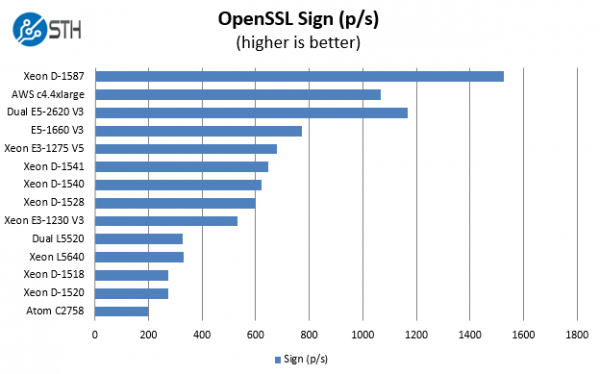
One can see here high-end speed of the Intel Xeon D-1587. Moving to the verify results:
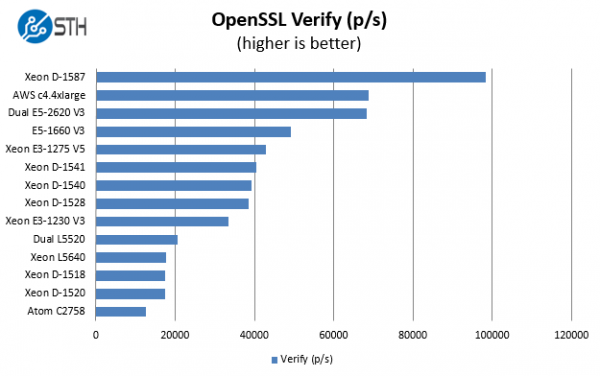
This was a bit unexpected, however Broadwell-DE (Xeon D) is a generation newer processor core than the Haswell-EP chips (Xeon E5-2620 V3) we tested. The OpenSSL results we saw were great. We were able to confirm this result on a second Xeon D-1587 platform.
UnixBench Dhrystone 2 and Whetstone Benchmarks
Of course, these chips are not meant for heavy compute but we pick out the UnixBench 5.1.3 Dhrystone 2 and Whetstone results to show some of the raw performance they are capable of. UnixBench is widely used so it is a good comparison point.
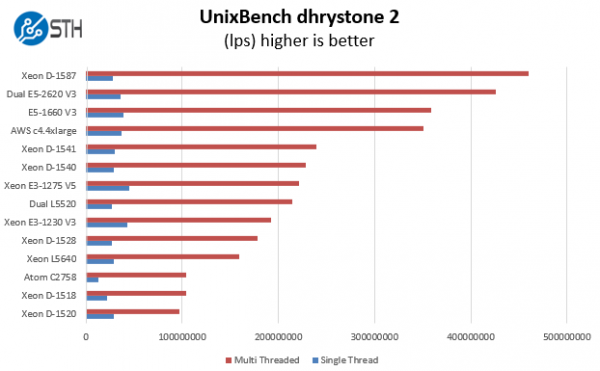
Again, single threaded integer performance is lacking on the D-1587, but the multi-threaded performance is great.
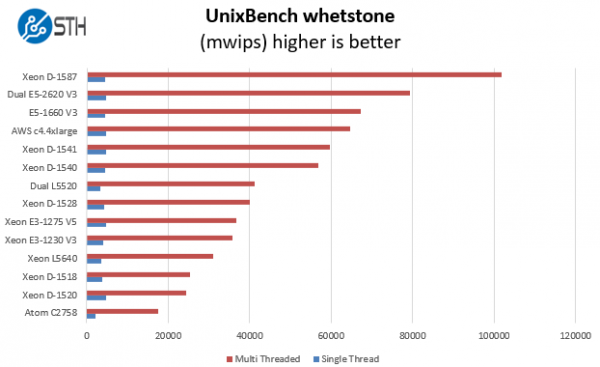
On the floating point side we see a similar trend. The new Xeon D-1587 is an extremely strong multi-threaded chip even though single threaded performance is lower than many other options.
HardInfo CPU Cryptohash
Perhaps some of the most standard benchmarks that come along with many versions of Ubuntu, the hardinfo suite has been a mainstay at STH.
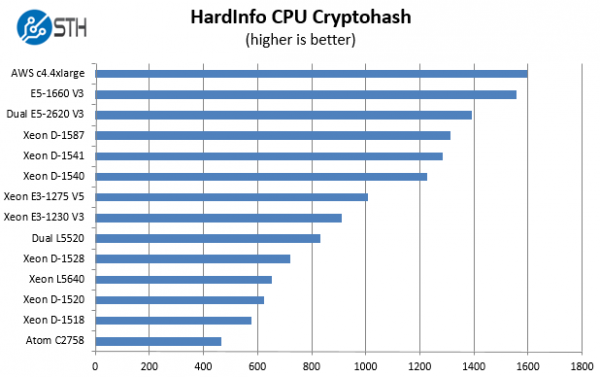
Here we can see an interesting result with the AWS EC2 c4.4xlarge instance actually pulling ahead and pushing the Xeon D-1587 into fourth in our results.
Conclusion
The Intel Xeon D-1587 performs well when one can load all cores, and assuming one does not need more than 128GB of RAM. The Xeon D-1587 is going to be priced high because Intel is going to want to protect the Xeon E5 line. While it may have multi-threaded performance similar to an dual Intel Xeon E5-2670 V1 or dual Xeon E5-2620 V3 system, given a larger power budget, those systems have more expansion capabilities. Where the pricing will make sense is when one can make up the differential is with operating costs as well as the integrated 10Gb MAC. As we will be showing in a subsequent piece, the power consumption of a 65W TDP single chip solution is excellent for the first time allowing an entire 16 cores/ 32 threads system to fit within a 120W operating envelope.

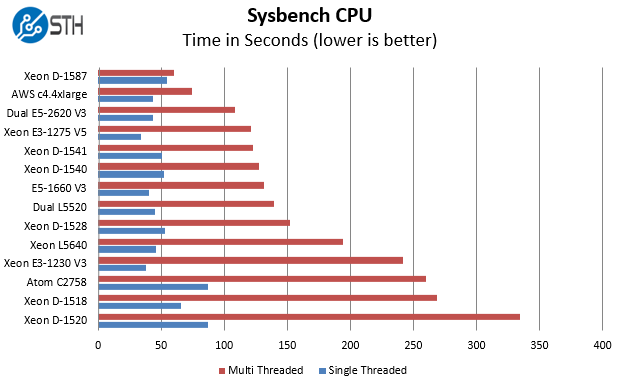



They keep adding cores to these things, but IMHO what they really need is more PCIe slots.
It has amazed me that the D-1520 and D-1540 have so little in the way of IO expansion.
I’d want to see these with 6+ x8 slots.
All these cores are useless to me without the I/O ability to load them.
That is unfortunately not going to happen, as it would cannibalize the E5 marked.
I hope to see the Linpack benchmark results for several systems including this Xeon D-1587 CPU.
Patrick, Could you load ESXi and see how well it can scale? Would be very interesting to see the max num of VMs (with some over-provisioning) one can run on this.
Thanks!
We do not have a standard ESXi benchmark. If you have something relatively easy to run, we can run it on this and other hardware.
I’d love to see how many 4k Plex streams this could transcode to say 1080